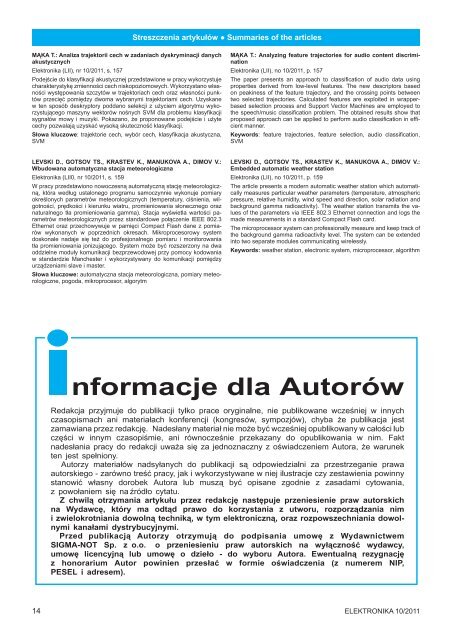Elektronika 2011-10 I.pdf - Instytut Systemów Elektronicznych ...
Elektronika 2011-10 I.pdf - Instytut Systemów Elektronicznych ...
Elektronika 2011-10 I.pdf - Instytut Systemów Elektronicznych ...
- No tags were found...
Create successful ePaper yourself
Turn your PDF publications into a flip-book with our unique Google optimized e-Paper software.
Streszczenia artykułów ● Summaries of the articlesMĄKA T.: Analiza trajektorii cech w zadaniach dyskryminacji danychakustycznych<strong>Elektronika</strong> (LII), nr <strong>10</strong>/<strong>2011</strong>, s. 157Podejście do klasyfikacji akustycznej przedstawione w pracy wykorzystujecharakterystykę zmienności cech niskopoziomowych. Wykorzystano własnościwystępowania szczytów w trajektoriach cech oraz własności punktówprzecięć pomiędzy dwoma wybranymi trajektoriami cech. Uzyskanew ten sposób deskryptory poddano selekcji z użyciem algorytmu wykorzystującegomaszyny wektorów nośnych SVM dla problemu klasyfikacjisygnałów mowy i muzyki. Pokazano, że proponowane podejście i użytecechy pozwalają uzyskać wysoką skuteczność klasyfikacji.Słowa kluczowe: trajektorie cech, wybór cech, klasyfikacja akustyczna,SVMMĄKA T.: Analyzing feature trajectories for audio content discrimination<strong>Elektronika</strong> (LII), no <strong>10</strong>/<strong>2011</strong>, p. 157The paper presents an approach to classification of audio data usingproperties derived from low-level features. The new descriptors basedon peakiness of the feature trajectory, and the crossing points betweentwo selected trajectories. Calculated features are exploited in wrapperbasedselection process and Support Vector Machines are employed tothe speech/music classification problem. The obtained results show thatproposed approach can be applied to perform audio classification in efficientmanner.Keywords: feature trajectories, feature selection, audio classification,SVMLEVSKI D., GOTSOV TS., KRASTEV K., MANUKOVA A., DIMOV V.:Wbudowana automatyczna stacja meteorologiczna<strong>Elektronika</strong> (LII0, nr <strong>10</strong>/<strong>2011</strong>, s. 159W pracy przedstawiono nowoczesną automatyczną stację meteorologiczną,która według ustalonego programu samoczynnie wykonuje pomiaryokreślonych parametrów meteorologicznych (temperatury, ciśnienia, wilgotności,prędkości i kierunku wiatru, promieniowania słonecznego oraznaturalnego tła promieniowania gamma). Stacja wyświetla wartości parametrówmeteorologicznych przez standardowe połączenie IEEE 802.3Ethernet oraz przechowywuje w pamięci Compact Flash dane z pomiarówwykonanych w poprzednich okresach. Mikroprocesorowy systemdoskonale nadaje się też do profesjonalnego pomiaru i monitorowaniatła promieniowania jonizującego. System może być rozszerzony na dwaoddzielne moduły komunikacji bezprzewodowej przy pomocy kodowaniaw standardzie Manchester i wykorzystywany do komunikacji pomiędzyurządzeniami slave i master.Słowa kluczowe: automatyczna stacja meteorologiczna, pomiary meteorologiczne,pogoda, mikroprocesor, algorytmLEVSKI D., GOTSOV TS., KRASTEV K., MANUKOVA A., DIMOV V.:Embedded automatic weather station<strong>Elektronika</strong> (LII), no <strong>10</strong>/<strong>2011</strong>, p. 159The article presents a modern automatic weather station which automaticallymeasures particular weather parameters (temperature, atmosphericpressure, relative humidity, wind speed and direction, solar radiation andbackground gamma radioactivity). The weather station transmits the valuesof the parameters via IEEE 802.3 Ethernet connection and logs themade measurements in a standard Compact Flash card.The microprocessor system can professionally measure and keep track ofthe background gamma radioactivity level. The system can be extendedinto two separate modules communicating wirelessly.Keywords: weather station, electronic system, microprocessor, algorithm14<strong>Elektronika</strong> <strong>10</strong>/<strong>2011</strong>
















